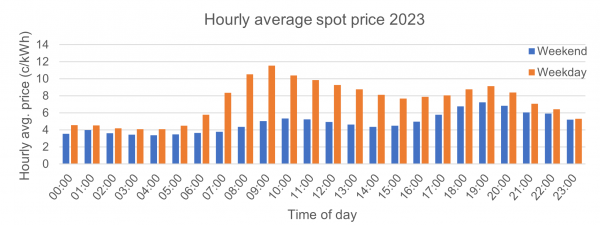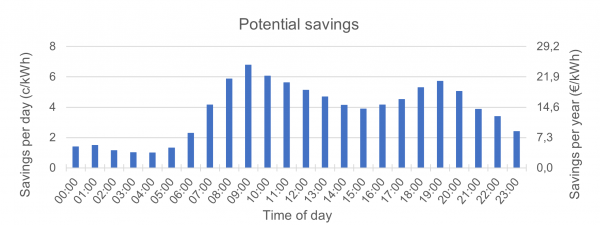Rantanen & Westö: ”Residential Demand Response: Financial Motivations Today and Future Prospects”

Artikeln har publicerats i Vaasa Insider 5.11.2024.
The writers are project expert Katariina Rantanen and project leader Johan Westö from Novia UAS.
Supply and demand must always be balanced to maintain the power balance in the electrical grid. Historically, this has been accomplished by primarily adjusting production to meet consumption. However, this is becoming challenging due to the increasing share of less controllable weather-dependent renewable energy sources, like solar and wind.
Demand response offers a solution by instead adjusting demand to meet the supply. Demand response thus represents an environmentally friendly way of stabilizing the electricity grid by shifting usage from times with a shortage to times when electricity is more plentiful, like when renewable energy is abundant.
In a well-functioning electricity market, the price indicates how easily supply can meet demand. Contributing to demand response is thus motivated by financial compensation, often in the form of a lower price for the electricity used.
Today, end-users can already benefit financially by signing electricity contracts with hourly prices linked to the electricity price on Nord Pool’s Day-ahead electricity exchange (also known as the spot price).
The spot price of electricity
The spot price is determined for each hour separately (every 15 minutes in the future) based on day-ahead forecasted values for supply and demand. Consequently, the price tends to be lower during hours predicted to have a high supply (windy hours) or low demand (nighttime and weekends) and higher during hours predicted to have a low supply or high demand. On average, this results in distinct price profiles for weekdays and weekends (see Figure 1).
On weekdays, the hourly price tends to exhibit two price peaks during the day, one in the morning around 9 o’clock and one in the evening around 19 o’clock. In contrast, the hourly price for weekends exhibits minor fluctuations and lower overall prices. These trends have been consistent for many years, but the increasing share of wind power has added more variability around these averages in recent years.

Potential savings
Consumers with spot-based electricity agreements can benefit from hourly price fluctuations by shifting their consumption to lower-priced hours. Some devices, like chargers for electric vehicles and heat pumps, already offer solutions that automatically try to shift usage towards lower-priced hours. The potential savings for doing so are proportional to the price difference between the original hour and the hour that usage was shifted to.
Figure 2 shows the average price difference between each hour and the cheapest hour of the same day during 2023. The bars thus denote the potential savings from shifting usage of 1 kWh to the cheapest hour of the day. For example, the possible savings from shifting 1 kWh from 9 o’clock to the cheapest hour of the day was roughly 0.07 € per day or 25 € per year during 2023.

Typical household devices consume 1–2 kWh per use, and the potential yearly savings from shifting use of these devices is roughly 15–50 € when used daily (shift from daytime, 7–21, to the cheapest hour of the day; see Table 1).
Production of warm water (electrical heating) and charging of electric vehicles use considerably more energy, up to 10 kWh per day, resulting in yearly savings of 150–250 €. For example, the savings from charging your car during the cheapest hours of the day instead of when coming back from work (around 18 o’clock) was roughly 200 € in 2023.

A need for smart devices and automation
The yearly savings from shifting usage from high-priced to low-priced hours range from tens to hundreds of euros. These are nonetheless modest savings given that usage must be reliably shifted towards lower-priced hours daily, thus necessitating some form of automation.
A second concern regarding current spot-based residential demand response practices is that they do not necessarily help stabilize the grid; the effect can even be the opposite. The problem is that the spot price represents what electricity companies pay to buy a fixed quantity of electricity to cover the forecasted demand of their customers for the next day. Any deviations in actual usage from the forecasted demand create an imbalance that must be balanced by trading on other electricity markets closer to the time of use but at an extra cost.
Unfortunately, the current practice of shifting usage based on known spot prices may increase the imbalance, as the shift decisions occur after electricity companies already bought the forecasted quantities on the day-ahead spot market.
Smart devices and home automation systems could help solve both concerns above. Both options make it possible to turn on and off devices automatically based on control signals (like price). Devices could even directly inform the electricity company about intended usage, thus making demand forecasts more accurate.
Smart devices and home automation could also facilitate aggregating demand responses from multiple consumers. The aggregated demand response could be sold in other electricity markets, where it is priced higher but where a minimum power limit stops individual households from participating, thus creating a greater financial incentive for demand response.
Conclusions
Residential demand response has considerable potential to help stabilize the electrical grid and move consumption to hours when renewable electricity is available. However, current practices do not necessarily help stabilize the grid, and the financial compensation is modest and only motivates installing the required automation for large loads, such as heating or electric vehicles.
Untapping the full potential of residential demand response requires smart devices or home automation systems for enhanced communication and control possibilities. This ensures that the provided flexibility helps stabilize the grid and potentially unlocks participation in more lucrative electricity markets where demand response is priced higher.
This work was done within the Novia UAS and VAMK project “Promoting electricity demand response management in Ostrobothnia”, co-funded by the European Union.
